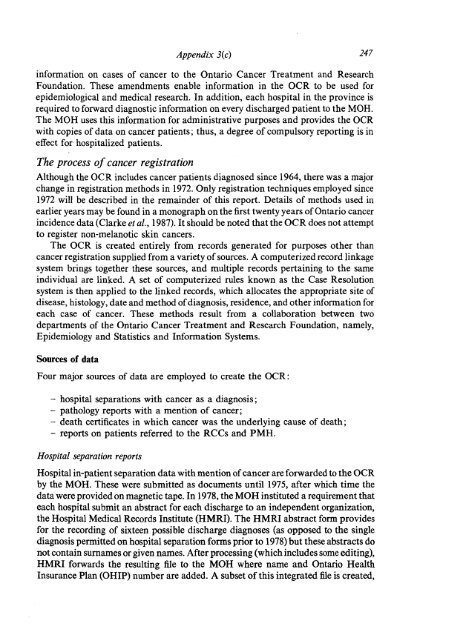Cancer Registration: Principles and Methods - IARC
Cancer Registration: Principles and Methods - IARC
Cancer Registration: Principles and Methods - IARC
Create successful ePaper yourself
Turn your PDF publications into a flip-book with our unique Google optimized e-Paper software.
Appendix 3(c) 247<br />
information on cases of cancer to the Ontario <strong>Cancer</strong> Treatment <strong>and</strong> Research<br />
Foundation. These amendments enable information in the OCR to be used for<br />
epidemiological <strong>and</strong> medical research. In addition, each hospital in the province is<br />
required to forward diagnostic information on every discharged patient to the MOH.<br />
The MOH uses this information for administrative purposes <strong>and</strong> provides the OCR<br />
with copies of data on cancer patients; thus, a degree of compulsory reporting is in<br />
effect for. hospitalized patients.<br />
The process of cancer registration<br />
Although the OCR includes cancer patients diagnosed since 1964, there was a major<br />
change in registration methods in 1972. Only registration techniques employed since<br />
1972 will be described in the remainder of this report. Details of methods used in<br />
earlier years may be found in a monograph on the first twenty years of Ontario cancer<br />
incidence data (Clarke et al., 1987). It should be noted that the OCR does not attempt<br />
to register non-melanotic skin cancers.<br />
The OCR is created entirely from records generated for purposes other than<br />
cancer registration supplied from a variety of sources. A computerized record linkage<br />
system brings together these sources, <strong>and</strong> multiple records pertaining to the same<br />
individual are linked. A set of computerized rules known as the Case Resolution<br />
system is then applied to the linked records, which allocates the appropriate site of<br />
disease, histology, date <strong>and</strong> method of diagnosis, residence, <strong>and</strong> other information for<br />
each case of cancer. These methods result from a collaboration between two<br />
departments of .the Ontario <strong>Cancer</strong> Treatment <strong>and</strong> Research Foundation, namely,<br />
Epidemiology <strong>and</strong> Statistics <strong>and</strong> Information Systems.<br />
Sources of data<br />
Four major sources of data are employed to create the OCR:<br />
- hospital separations with cancer as a diagnosis;<br />
- pathology reports with a mention of cancer;<br />
- death certificates in which cancer was the underlying cause of death;<br />
- reports on patients referred to the RCCs <strong>and</strong> PMH.<br />
Hospital separation reports<br />
Hospital in-patient separation data with mention of cancer are forwarded to the OCR<br />
by the MOH. These were submitted as documents until 1975, after which time the<br />
data were provided on magnetic tape. In 1978, the MOH instituted a requirement that<br />
each hospital submit an abstract for each discharge to an independent organization,<br />
the Hospital Medical Records Institute (HMRI). The HMRI abstract form provides<br />
for the recording of sixteen possible discharge diagnoses (as opposed to the single<br />
diagnosis permitted on hospital separation forms prior to 1978) but these abstracts do<br />
not contain surnames or given names. After processing (which includes some editing),<br />
HMRI forwards the resulting file to the MOH where name <strong>and</strong> Ontario Health<br />
Insurance Plan (OHIP) number are added. A subset of this integrated file is created,
















